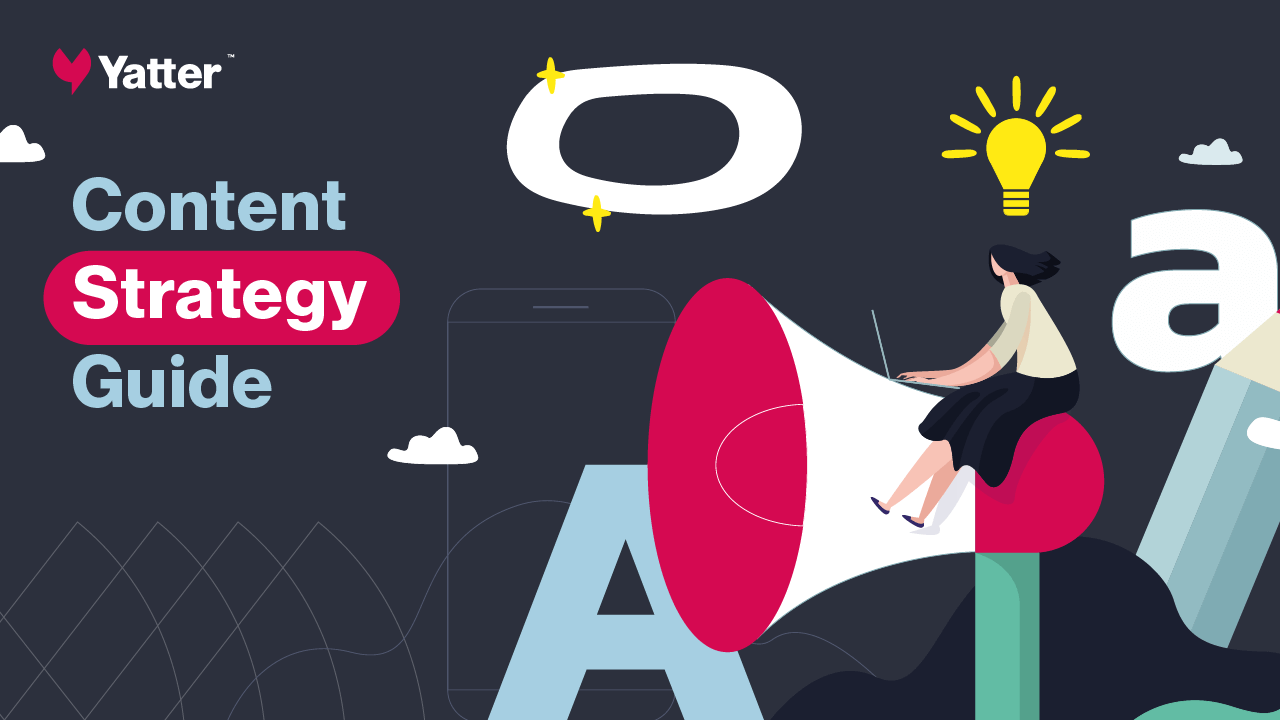After working with thousands of businesses across the world, we’ve found one undeniable truth: those who commit to creating content have more success than those who don’t.
There’s a reason behind that. Consumer purchasing behaviour has changed. Not too long ago, it was possible for you to throw up any old ad and have people click and buy your stuff, but not so much anymore.
Consumer attention is harder to get and buyers are more informed than ever before. As informed consumers, they need to feel like they know, like and trust you before they buy from you.
We need to adapt to this new way. And the best way to do that? By creating & distributing content as part of our advertising campaigns
Where do you start? With a content strategy plan!
Creating a strategic plan for your content is a surefire way to ensure your content is consistent. It will help you focus on producing quality content that will engage your audience.
And… it’ll help your advertising campaigns massively.
Luckily for you… we’ve created a quick guide on how you can create your own content strategy. Read til the end for some answers to frequently asked questions.

What Is Content Marketing?
First, before we discuss the “how” I want to share the “what”. What actually is content marketing? And what does it mean to create content?
Here’s my favourite definition:
“Content marketing is the art of communicating with your customers and prospects without selling. It is non-interruption marketing. Instead of pitching your products or services, you are delivering information that makes your buyers more intelligent or perhaps entertaining them to build an emotional connection.”
Most businesses will post for the sake of posting… and that does nothing, other than create noise.
Instead, we want to focus on posting something of real quality – consistently.
Facebook’s algorithm (and every other platform) rewards content that is either educational or entertaining – so we should always be aiming to create something that’s one or the other – or both!
Facebook has three main goals:
1. To get more people on the platform
2. To have their users spend more time on the platform
3. To make more ad revenue (done by achieving 1+2)
Now, if you’re like most, you’ve probably dabbled in your fair share of “promotional” or “salesly” posts on Facebook. You’d be forgiven… of course, you want to sell on Facebook.
But we politely ask you to stop that 😉
To have the most success on Facebook, you need to cater to their goals. If you create high-quality content that has people coming back to Facebook and engaging with you, Facebook will reward you with cheaper reach.
Meaning you get more eyeballs on our page, brand, content & offers.
Why Should You Do Content Marketing?
As with any business activity, there has to be a real business case for it. There’s no denying that content creation can be hard and time-consuming, so why do you need to do it?
1. It Makes Selling Easier
The hardest prospects to sell are the ones that don’t really know what they signed up for. They just sign up for something to “learn more”.
You shouldn’t be speaking to someone who isn’t already qualified. Because, as you know the sales conversation is like fighting an uphill battle.
Content allows you to educate these people to become better prospects BEFORE you have to speak to them…
This means when you do finally speak to them, they’re much warmer (and educated) and there’s a higher chance of you making the sale. Your close rate will almost certainly improve.
2. Drown Out The Competition & Become The Only Option
Have you noticed every single industry has its “celebrities”? The businesses/brands that have the largest audiences and seem to get all the opportunities?
You might even have competitors who seem to win more business than you, even though you know you offer a better service.
This is because they’ve been able to build a larger audience than you. They have a larger group of people who know, like and trust them.
The most optimal way for you to build an audience like that is by producing and distributing high-quality content that educates and solves the problems faced by your customer.
The more content you produce and the larger your audience, the harder it becomes for any competitor to have a say in the market.
3. High-Quality Leads That Are Ready To Buy
If someone has consumed your content, they have effectively qualified themselves.
For example, let’s say you create a video called “5 Ways To Remove Your Back Pain”…
If someone watches that video, you can almost guarantee they have back pain. Otherwise, why would they watch it?
With our campaigns, we’re able to target ads directly to the people who have watched your videos. This is insanely powerful.
One of the biggest complaints we hear from business owners working with other agencies is that they can generate leads, but they’re always low quality. By creating content and prequalifying the prospect, we solve that problem.
Determine Your Goals
Now you know the “whats” and the “whys”, you need to set your goals.
What are your business goals and KPIs? How can your content support your goals? What’s the dream outcome of your content marketing efforts?
This will help you determine the best course of action and measure your success.
Content is a long-term game though so people won’t get that results quickly, so often better goals to focus on are just getting started & committing to posting regularly
By setting your goals, you’ll be able to find what type of content is going to work best for you and your customer.
Who’s Your Perfect Customer?
We always want to make the customer our key focus.
The content, of course, should push their decision to buy your product/service but should also solve their problems and answer their questions. You also want to amplify your brand awareness.
Some questions to ask are:
- Who are we reaching?
- What do they want to see?
- What problems do these customers need to solve?
Do some research into what content your audience already engages with and where they already visit i.e Instagram, Facebook etc. There’s no point in creating content on a platform where it will get lost in the void.
At Yatter, the first thing we do is ask our clients to fill out our onboarding form. This is a long-form that take clients through everything we need to get started, such as:
- Questions regarding your perfect customer
- An understanding of your business & numbers
- Access to your customer lists (for custom audiences) & creatives
Try creating your own version of this so you have all the information you need.
One of the main sections of our onboarding form is around the dream customer. We ask clients for 5 main things (and you should do this too):
- Demographics – where does your customer live, etc.
- Psychographics – what is your customer interested in?
- Problems – what problems do your customer have?
- Results – what results do your customers want?
- Vehicle – what are the benefits of your product/service that helps someone solve their problems and achieve their desired results
By establishing your desired audience, you’ll have context on what offers your competitors have, who’s advertising in your space and what’s working in the industry as a whole.
By diving deep into all of the above, we’re able to see what our best approach will be. The more information we collate, the more effective your content will be.
Content Pillars
There are so many options when it comes to content creation that it can become overwhelming very quickly.
This is why we think it’s important for you to come up with your own content pillars.
Content pillars are the main types of content that you simply repeat each work, 1-2 weeks in advance where possible.
Here are some pillar ideas that work across all types of business:
Answer questions to the camera
Simply stand in front of the camera and answer the most common questions you get asked on a daily basis. Tailor the questions to be around objections, problems & benefits.
This means your potential clients can easily find answers to any queries they have, and it saves you time and energy. It will also show how attentive you are to your customer and how proactive you are at fixing problems.
If someone is googling questions, we want your video or blog to be the first one to pop up.
Customer Testimonials
Ideally, this would be in video format so people can hear directly from your customers.
People trust other people’s endorsement. By having your existing client’s video, it adds a personal element rather than just a written testimonial which for all the customer knows could be faked.
How-to’s
Film how you do your day-to-day job.
This gives the viewer an insist into what you do and creates a connection between the two of you.
Vlog
Create a short vlog of your day.
You can talk to the camera or simply film clips as you go about your day then put a voiceover on top. Again, this is going to show personality to the customer and show you are real people, not just a brand.
Before & After
Photos and videos before/after your service.
For example, if you worked in property development, a photo of your property before and after. This will show the customer how effective your product/service is.
Cool features
Share some photos and videos that showcase the best about your brand.
Your audience will love to see what sets you apart from other brands and what makes you special!

Choose the type of content that works best for you! Video content will definitely get you better results. A Study by Hubspot showed that an overwhelming majority of people (96%) report watching explainer videos to learn more about a product, with 88% being swayed to make a purchase.
It’s great to get your whole organisation involved in the content-creation process. This helps with your time personally but will also help with the professionalism of the brand. If it only comes from one person, it makes the brand feel smaller.
Throughout all of the above, you should be subtly mentioning why your company is the best option: save money, great products etc.
Start Creating!
There’s no doubt that this is the hardest part.
The main pushback we get here is: “I don’t have the time!” But please, remember this: content marketing is a time SAVER.
Chances are you are answering these same questions every single day. All we need you to do is pick up your phone/camera and answer a short 1-2 minute video answering them. And once you’ve done that, you’ll no longer need to answer it… you can simply direct people to the video.
Posting Your Content
Now you’ve created your content using our pillars and you know where’s best to put it; let’s get posting!

Use a tool like Buffer to post across all channels and pick 2-3 days per week where you cycle through the pillars above.
With over 2.9 billion active users logging in monthly, Facebook continues to dominate the social media atmosphere, so it’s a great idea to start there!
TikTok is another great platform to post on. TikTok’s usage has grown by 45% since 2020 and it’s not going to slow down any time soon.
The best time to post on social media is early morning on a weekday. So when your audience wakes up, your post will be one of the top pieces they’ll see during their morning scroll.
According to the same article, the worst day to post is Saturday!
Take a look at previous content and see what posts were most effective. What were they and when were they posted?
Try testing out your data by scheduling your posts when you think you will get high engagement.
Distributing Your Content Effectively
Once the content has been posted, it’s time to distribute it as much as possible.
If you’ve created a long video for YouTube, splice it up and share it as a shorter video on Facebook. On Facebook, the easiest way to do that is by sharing your posts with relevant groups.
If you’ve created a blog post, summarise your key points in a Twitter thread. You’ll be able to share out one piece of content into several different versions on several platforms.
Next steps, you can use the content in your ad campaigns to drive awareness and build your audience for retargeting campaigns. The ad component is the most important as you can create good content and use ads to distribute that across the country at little cost.
Measure Your Results
When it comes to measuring success with content, the initial thing to look for is just getting started – that’s the hardest part.
If you can just get posting for say 6 weeks consistently, that’s a huge win!
From there, you’ll start to see a trend of what works and what doesn’t work. You’ll start to see that you get a consistent amount of engagement with every post. That might be 1 like, 10 likes or 100 likes depending on the business.
Whatever that number is for you, you’ll start to see content that does better than this and content that does worse than your norm.
You want to make more of what works and less of what doesn’t!
Listen to your customer too instead of basing everything on data. Ask them for feedback on what they liked/disliked and suggestions for improvement. This shows them that their opinions matter and you get better results. It’s a win-win.
Ask your staff and sales team what they think. After all, they know first-hand what the customers are saying.
And That’s a Wrap
Content strategy planning takes a lot of trial and error.
The main thing is: just get started!
This content strategy guide is a lot to unpack, so get in touch with us and we’ll be happy to help you!
Keep this guide handy as you start creating your content. Happy creating!
FAQ’s
What is the perfect length of a video?
This is probably the most common question we receive. And the answer is (I’m sorry): it depends… There really is no right or wrong answer. But I always suggest you try and keep your videos as short as it needs to be. If that means a video has to be 5 minutes to explain a topic, no problem. But always aim to be shorter.
Somewhere in the region of 60-120s is a good place to start.
We have seen some real success with super short videos recently (under 15s) so feel free to get creative too!
My brand is high-class, and I want to create something professional. What do you suggest?
If you’ve got a higher-class brand, I totally understand the need to keep that up. But don’t ever let that get in the way of creating.
If you have the capability of regularly hiring video experts to shoot professional videos in line with your brand, do it. But don’t ever let the need for high-end stop your ability to create.
People crave realness. They want to see the behind-the-scenes. And as you scroll through your Facebook feed, 90% of the videos there are created on a phone. Rough, raw videos tend to outperform the higher-budget, professional ones!
How often should we create content? How much time do I need to commit to creating content?
Consistency is key. I would always aim to produce one high-quality piece of content per week. But to make it easier (and more time effective) for you, we recommend batching.
Book out 1-2 hours per month to sit down and shoot 10 videos. Then, you’ve got a buffer of content you can share regularly.
Do we have to produce video content?
Video content isn’t required, but it’s definitely recommended as it’ll always give better returns.
If video simply isn’t an option, we recommend you produce written articles on your site. Podcasts are great, but they can’t be fed into our system like blogs/video.
If you simply can’t produce anything – the very least we require would be consistent photos.
Do you have a script for what I should say in our videos?
We do have specific scripts for specific videos, but a general script for when answering the questions you receive would be:
“Hey I’m _____ from _____,
A question I’m asked on a daily basis is: __________. It’s a great question because _______.
Back pain typically arises _________”
Simply answer the question as if you were answering a customer face to face. Keep it simple. Don’t use industry language and speak using the words THEY would use.
How do you recommend we edit the videos?
As a general rule of thumb, never start the video with a logo or template. The average watch time for a video on Facebook is just 6s, so it’s vital you grab their attention. Your logo, no matter how beautiful, simply won’t do that.
Second of all, every video should use captions. The majority of people on Facebook watch videos without sound, so we want to ensure they’re able to watch our video without it. If we don’t have captions, they’ll simply skip it.
We recommend using Rev.com to get captions made for your video at just $1.25 per minute.






